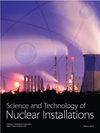Tritium Breeding Performance Analysis of HCLL Blanket Fusion Reactor Employing Vanadium Alloy (V-5Cr-5Ti) as First Wall Material
IF 0.9
4区 工程技术
Q3 NUCLEAR SCIENCE & TECHNOLOGY
引用次数: 0
Abstract
Neutronic analysis in the HCLL blanket module has been established, and the calculation was performed by the ITER team, including the first wall (FW). In this study, seven materials have been investigated for FW material by considering characteristics such as high neutron fluence capability, low degradation, under irradiation, and high compatibility for blanket material. A three-dimensional configuration simulated in MCNP5 program codes was performed to investigate the neutronic performance and radiation damage effect. Employing seven candidates are vanadium carbide (VC), titanium carbide (TiC), vanadium alloy (V-5Cr-5Ti), graphite (C), tungsten alloy (W-CuCrZr), ceramic alloy (SiC), and HT-9 to study optimization of FW materials configurated in the HCLL blanket module. This novelty study concludes that vanadium alloy (V-5Cr-5Ti) is becoming a promising material candidate. This alloy has the highest number of neutronic performing for 1.27 TBR and 1.26 in multiplication energy factor in all investigations. Meanwhile, the amount of atomic displacement, hydrogen, and helium production are around 22.31 appm, 765.55 appm, and 281.57 appm, respectively. Even though vanadium alloy has a reasonably high radiation damage effect, it is still tolerable compared to several thresholds of DPA. So, it is considered excellent material for FW. Nevertheless, this alloy can replace after 13.45 years for radiation damage.钒合金(V-5Cr-5Ti)作第一壁材料的HCLL包层聚变堆氚增殖性能分析
HCLL包层模块中的电子分析已经建立,计算由ITER团队执行,包括第一壁(FW)。在本研究中,考虑到高中子注量能力、低降解、在辐照下以及与毯子材料的高兼容性等特性,对FW材料的七种材料进行了研究。在MCNP5程序代码中模拟了三维配置,以研究中子性能和辐射损伤效应。采用碳化钒(VC)、碳化钛(TiC)、钒合金(V-5Cr-5Ti)、石墨(C)、钨合金(W-CuCrZr)、陶瓷合金(SiC)和HT-9七种候选材料来研究HCLL毯子模块中FW材料配置的优化。这项新颖的研究表明,钒合金(V-5Cr-5Ti)正成为一种有前途的候选材料。在所有研究中,该合金在1.27 TBR和1.26的倍增能量因子下具有最高的中子性能。同时,原子位移、氢和氦的产生量约为22.31 应用程序,765.55 appm和281.57 appm。尽管钒合金具有相当高的辐射损伤效应,但与DPA的几个阈值相比,它仍然是可容忍的。因此,它被认为是FW的优秀材料。尽管如此,这种合金在13.45年后可以代替辐射损伤。
本文章由计算机程序翻译,如有差异,请以英文原文为准。
求助全文
约1分钟内获得全文
求助全文
来源期刊

Science and Technology of Nuclear Installations
NUCLEAR SCIENCE & TECHNOLOGY-
CiteScore
2.30
自引率
9.10%
发文量
51
审稿时长
4-8 weeks
期刊介绍:
Science and Technology of Nuclear Installations is an international scientific journal that aims to make available knowledge on issues related to the nuclear industry and to promote development in the area of nuclear sciences and technologies. The endeavor associated with the establishment and the growth of the journal is expected to lend support to the renaissance of nuclear technology in the world and especially in those countries where nuclear programs have not yet been developed.
 求助内容:
求助内容: 应助结果提醒方式:
应助结果提醒方式:


